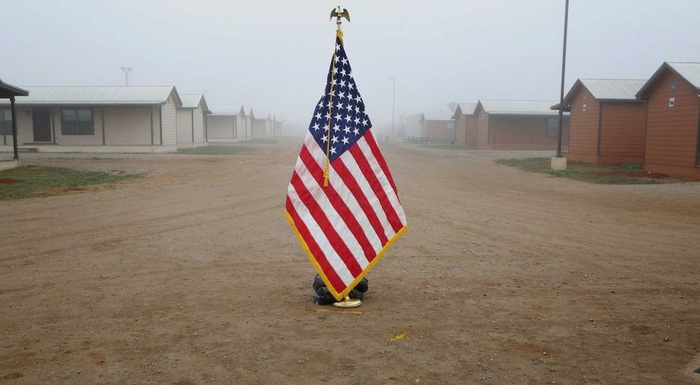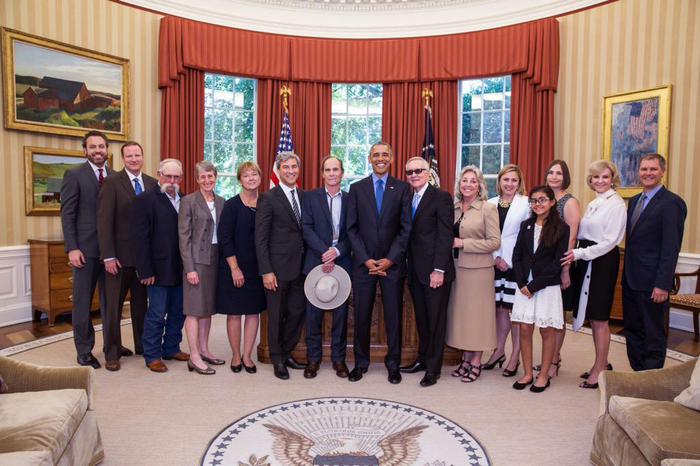I have added some prints found during the earliest days of the eBay Test Listings project, but only made available now for sale and entertainment which, after all, are the same thing.
July 2015 Archives
July 30, 2015
New eBay Test Listings Prints
July 28, 2015
The Berkowski Daguerrotype

The first successful photographic image of the sun's corona was taken 164 years ago today. A daguerrotypist named J. Berkowski was brought to the Royal Observatory in Königsberg, Germany (now Kaliningrad, Russia) by the director, Augustus Busch, to record a solar eclipse on 28 July 1851. According to this 2005 paper in Acta Historica Astronomiae, Berkowski soon made some daguerrotype reproductions. Busch commissioned Robert Trossin of the Royal Academy of Painting to make a steel engraving of the daguerrotype. In 1891, CFW Peters had Berkowski's original daguerrotype photographed for publication. It has since been lost.
Four of Berkowski's copies were known, including one in the Jena Friedrich Schiller University in Jena, Germany [above]. The order of copying events in the Jena description does not quite line up with the 2005 paper, even though the author, Dr. Reinhard Schielecke, is the same.
The moon in the 2nd-generation daguerrotype is tiny: 8.7mm across. The original was under 8mm. The Jena print is thus only around 5x6cm, as wide as the screen on an iPhone 4s, but shorter. It was recently conserved, and the Google translation makes me wonder if images of the daguerrotype have been Photoshopped a bit.
I don't expect to beat diehard collectors of Prussian daguerrotypes to the rediscovery of another of Berkowski's prints. It would probably be easier to start from scratch and make a new daguerrotype of a solar eclipse somewhere.
ABSTRACT: "On the Berkowski daguerreotype (Königsberg, 1851 July 28): the first correctly-exposed photograph of the solar corona" [adsabs.harvard.edu via @coryspowell]
Daguerreotypie der Sonnenfinsternis vom 28. Juli 1851 [museum-digital.de]
Konservierung der Berkowski-Daguerreotypie abgeschlossen [daguerrotype-gallery.de]
July 24, 2015
Libre Soy, Libre Soy
Based on this photo at the opening of the world's largest family detention center in Dilley, Texas last January, I'd say San Antonio Express News photographer Bob Owen is very familiar with Dorothea Lange's photos from the Japanese American detention camp at Manzanar, CA. It's almost like the only thing that's changed in this country since WWII is now the government outsources its illegal, immoral detention of non-white children to a giant, for-profit prison company.
And what do kids do in Dilley, besides get dangerously incorrect vaccinations and medical treatment?:
While children wait for their mothers to talk to lawyers and legal aids, they are usually watching kids' movies dubbed in Spanish, namely Rio or Frozen. The children of Dilley, like children everywhere, have taken to singing Frozen's iconic song "Let It Go."Do you know the chorus of "Let it Go" in Spanish? I did not, but it is one helluva song for kids to be singing in a corporate prison in 2015:The Spanish-language refrain to the song "Libre soy! Libre soy!" translates to "I am free! I am free!" It's an irony that makes the adults of Dilley uneasy. Mehta recalls one mother responding to her singing child under her breath: "Pero no lo somos" (But we aren't).
Libre soy, libre soy
No puedo ocultarlo más
Libre soy, libre soy
Libertad sin vuelta atrás
Y firme así me quedo aquí
Libre soy, libre soy
El frío es parte también de míI am free, I am free
I can't hide it anymore
I am free, I am free
Freedom without turning back
And I'm staying here, firm like this
I am free, I am free
The cold is also a part of me
'Drink more water': Horror stories from the medical ward of a Texas immigration detention center [fusion.net]
which is basically a re-reporting of this: Immigrant families in detention: A look inside one holding center [latimes]
Ansel Adams, Born Free And Equal, 1944 [loc.gov]
Related: Translating "Frozen" into Arabic [newyorker]
"Let it Go" in 25 languages [youtube]
July 16, 2015
Court Order, Or What Would Danh Vo Do?
What Would Danh Vo Do? Send in your proposal today! Must be "large and impressive"! #wwdvd
— gregorg (@gregorg) July 7, 2015Oh no, I was too slow. I was in the middle of a deadline-intensive project when I suggested that. While I understood the reluctance, even the revulsion, an artist might feel, but being compelled by a judge to make a "large and impressive" artwork--and a $350,000 one, no less--sounded like a fascinating situation. What would you do?
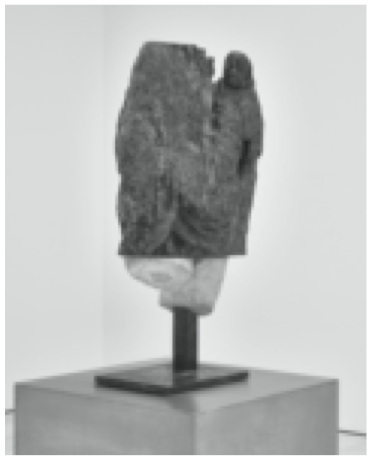
..., 2015, oak and polychrome Madonna and child, French Early Gothic 1280- 1320; marble torso of Apollo, Roman workshop, 1st-2nd century ad; steel 154.2 × 50 × 50 cm
Courtesy of the artist and Marian Goodman Gallery [works list (pdf) via palazzograssi.it]
Well, today, just as I was mapping out the parameters of my own proposal, Danh Vo apparently answered that question himself. His proposal to Dutch-in-Switzerland collector Bert Kreuk was a little unclear in the details, but it involves a quote from the demon possessing Regan in The Exorcist, which Vo had also used for a piece in his show at Marian Goodman in London last January, and which he included in "Slip of the Tongue," his fantastic group show at Punta della Dogana in Venice. [I guess it's still available. Ask for it by name!]
Maybe Vo already had this whole Kreuk/Gemeentemuseum/lawsuit situation on his mind when he chose The Exorcist for his source material. Who knows? But the artwork parameters cited in the court's new ruling in Kreuk's lawsuit are intriguing enough to lay out, and at least give some though to the question: What Would Danh Vo Do?
July 16, 2015
Lightning Field Notes
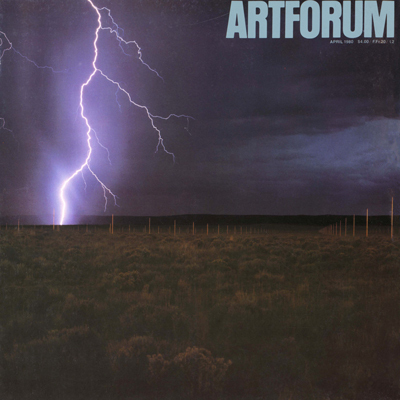
John Cliett's photo of Walter de Maria's The Lightning Field, 1977, on the cover of Artforum (Apr. 1980)
From the beginning, access to The Lightning Field has been tightly monitored by the administrative machine surrounding the project. Visitors to the site are required to spend the night and are not allowed to take photographs during their stay. Indeed the entire project is predicated on the viewer's personal physical experience of the work in its location. Yet, at the same time, the artist and his patrons have also sought to stake out a particular presence in the wider discourse of contemporary art for The Lightning Field, a goal they have accomplished in part through a carefully orchestrated approach to photographic documentation.Well beyond the artist's own writing, Jeffrey Kastner's interview with The Lightning Field photographer John Cliett has been central to my understanding of the work since 2001.[John] Cliett worked from the beginning with De Maria on formulating the scheme for photographing The Lightning Field; many of the most often-reproduced images of the Field, including those which famously introduced it to the art world in the pages of the April 1980 issue of Artforum magazine, come from his two summer sessions. Indeed, that so many viewers have come to know The Lightning Field through these images--a fraction of the total he took, strategically promulgated over the years by the artist and Dia--emphasizes their essential role in the artist's plan for shaping the image and promoting the "idea" of the work.
Cliett told of taking the extraordinary, iconic, and extremely difficult pictures of The Lightning Field, but also of how images are antithetical to de Maria's concept for the work. This contradiction between the artwork and the art system surrounding it generated tension similar to other Land Art. During the 1970s and 80s when Robert Smithson's Spiral Jetty was considered "lost" or invisible under the Great Salt Lake, the artist's film became the focus of critical attention.
De Maria felt that even this iconic imagery, which Cliett later jokingly compared to "a Pink Floyd album cover," could only ever fail to communicate the experience of the work. "Walter's work is designed to create an environment where a viewer can have a highly personal relationship with a work of art that is completely unique to each individual," Cliett said.
But the images had another purpose, controlling the discussion of the work, as I was reminded when I re-read Kastner's interview this summer:
With respect to the copyright, if you control the picture of a work of art, you will control everything that's said about it, because nobody will publish an article without pictures. So you get the right to pick, and that's a very powerful thing.Yes, well.
After many discussions, dreams, and failed attempts over 22 years, we managed to get a trip to The Lightning Field together for this summer. We built the rest of our cross-country road trip around it and got home a couple of weeks ago. A visit takes basically 21 hours, starting at 2pm, no stragglers. Dia's folks on the ground drive you to and from the remote site. There is room for six people in the cabin; in addition to our family of four, there was a young couple from Brooklyn.
I'm not sure when I decided to livetweet our visit to The Lightning Field, maybe after I started seeing people I knew from Twitter in the registry. Or when I read one excited, tweet-sized comment left by a dealer about soaking in the sublime, which seemed like a lot to feel before you even get there. And so as I was about to learn the difference between an image and an artwork, I started thinking about real and virtual, individual and network, living and publishing, an account and an experience, a livetweet and IRL.
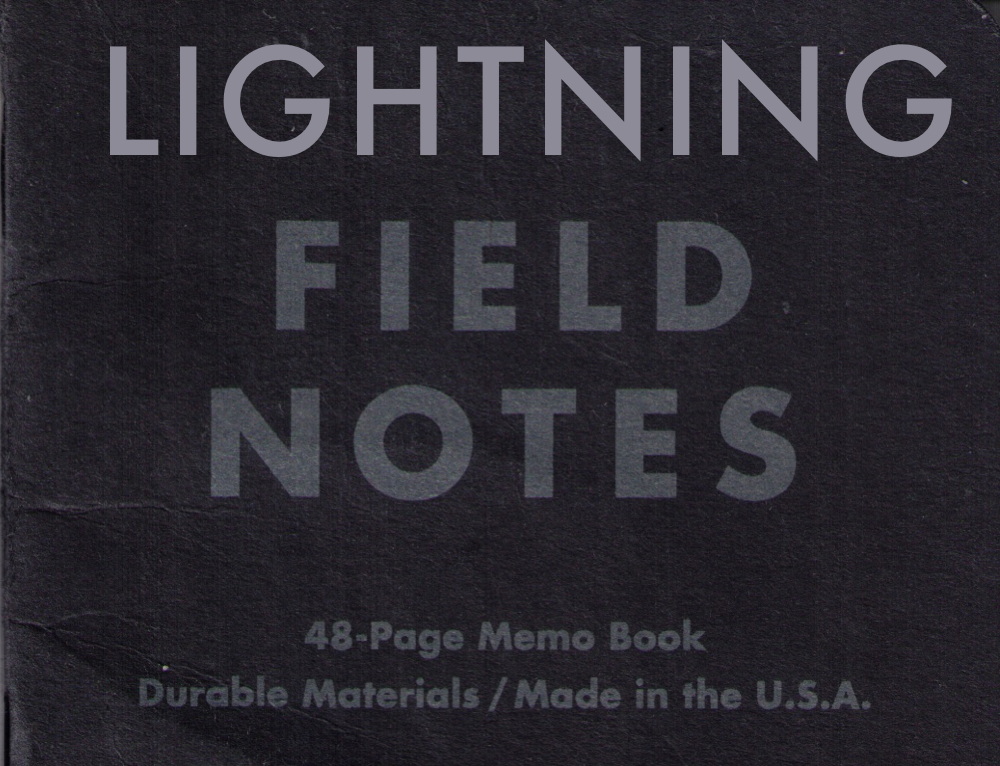
Without wanting to blow my actual encounter with The Lightning Field, I was interested to isolate what happens when you approach an experience with a livetweeting mindset: do livetweeters dream of 140-character sheep? Since there was cameraphones, and no hope of connectivity anyway, I decided to write my tweets down. My black Field Notes book looks very iPhone-ish, and I was quickly aware of being glued to it like any other screen, so I did not write every tweet in real time; I'd put some in my mental drafts folder and batch them.
There's still a lot that didn't make it in. Stuff I left out. But from there, also what de Maria left out. After several ventures into and around the Field, the artist's almost total silence on the land itself is stunning. "The land is not the setting for the work but part of the work," wrote de Maria, in bold, at the beginning of his Artforum essay. He wrote that the site was "searched by truck over a five-year period," and that's about it. The entire rest of his statement is about the hyper-precise calculations, surveying, and technical challenges of manufacturing and installing the poles. There are two pages of credits for the companies and construction workers involved.
Like Cliett's photos, de Maria's industrial fetish text was intended to manage the discourse around the work. No one could dismiss it as nonsensical, non-serious or unintentional. And it's not some basement project, either; this is not your grandpappy's mile of fence. Yet the only way to get around The Lightning Field is on foot, and the landscape makes you literally watch every step. And then there were the coyotes howling at sunrise, hoo boy, that was freaky.
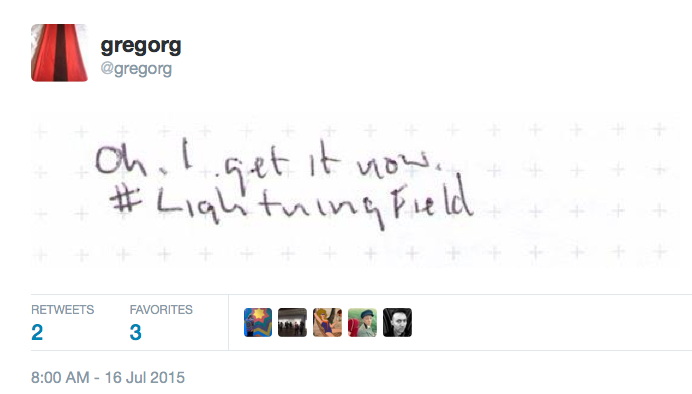
I ended the livetweeting right before our ride came, but one of the most interesting parts for me was the drive back to town, and the conversation with Kim, the longtime Dia staffer who runs the guest program on the ground. I decided not to tweet that, though, just as I didn't really mention our cabinmates too much. Besides basic respect for their privacy, I figure that's also truer to the work: tweets aren't reporting, but a reflection of a single, individual experience.
Once I had this notebook of tweets, I had to figure out what to do with it. I scanned them and figured I'd play them back, tweet them in real time. That idea quickly ran afoul of my schedule. I guess I could have set a script to automatically post them at the prescribed times, but instead I tweeted each by hand, beginning yesterday at around 2 o'clock New Mexico time. I didn't anticipate the friction of overlaying this recap of The Lightning Field with my back-to-normal life. Where visiting The Lightning Field was an intensely physical experience, livetweeting The Lightning Field became all about time. I could not anticipate the next tweet accurately; I was always way too early. I got in trouble for tweeting at the dinner table. I realized only after I started that twitter-as-usual would kind of blow the whole thing, so I stopped retweeting and responding to people until it was done. [Sorry!]
I may work the tweets up into an edition, a facsimile notebook or something. Dan Perjovschi made a little sketchbook facsimile for Kunsthalle Basel a few years ago that I like, and Field Notes are the perfect on-brand readymade. Or maybe I'll do some other project, involving barnwood, Hudson's Bay blankets and yoga mats. I don't know yet, but something's sure to come of it.
July 14, 2015
Sforza, Heizer. Heizer, Sforza.
If I had to make a list of photo ops I could never imagine, Michael Heizer standing alongside Pres. Obama and Sen. Harry Reid would be right up there. And yet here we are.
Heizer, along with LACMA director Michael Govan and others, gathered to celebrate the designation of the Basin & Range National Monument, which protects 704,000 acres of Nevada wilderness, ranchland, and Heizer's decades-long project, City, from oil extraction or encroaching development.
Spiral Jetty's on 10 acres. Lightning Field's on a few thousand, plus DIA's bought up 9,000+ surrounding acres to protect the view. With 700K plus a high-powered entourage at the White House, it's as if Heizer has out-Earthworked all the Earthwork artists with the biggest Earthwork on Earth.
[via @RepDinaTitus]
July 7, 2015
OTD: OG Cady Noland At Luhring Augustine Hetzler
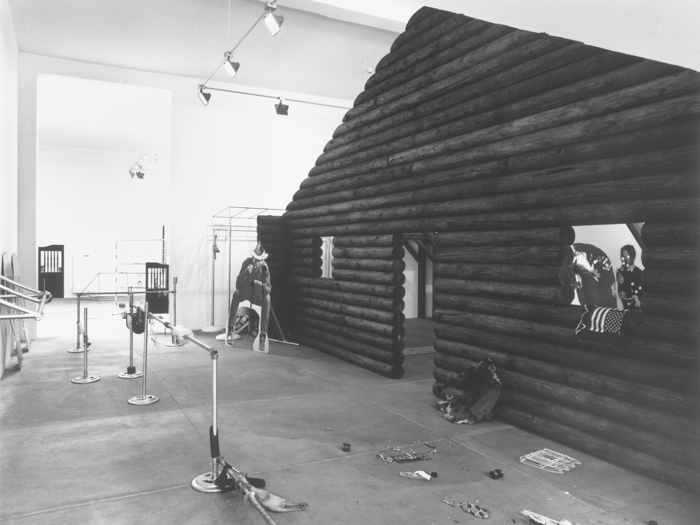
On July 7, 1990 Cady Noland opened a solo show at Luhring Augustine Hetzler, the NY- and Cologne-based galleries' short-lived colabo space in Santa Monica.
Look at it, just look at it. Is there a better place than the end of the America for all this treasure to wash up? There is so much going on here.
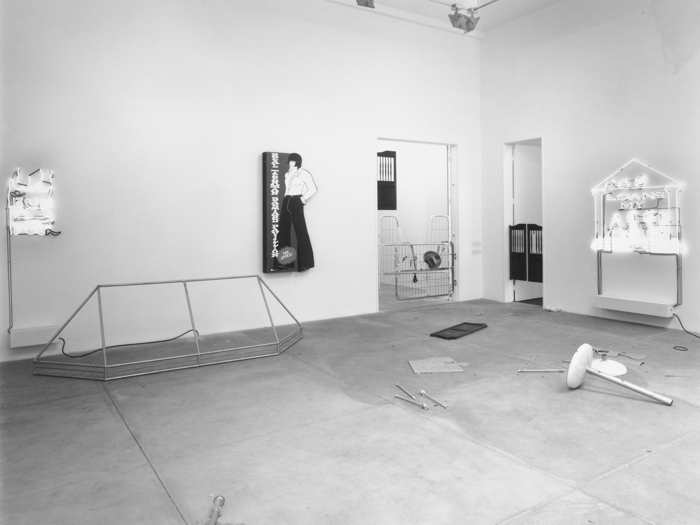
Log Cabins, Cowboys, Oswald, and the SLA were all there, but there is so much we don't see or hear about now: Neons. Naked Awnings. Broken down floor lamps. Saloon doors, What is that manly ad?
You know who might know? Rawhide-at-Venus-Over-Manhattan curator Dylan Brant, who was probably born in 1990, but who wrote his 2014 senior project at Bard on Noland's Santa Monica show, something about understanding Noland's language and meaning about "schizophrenic America." Sounds lively. I'm going to keep studying the pictures myself.
Cady Noland | Santa Monica, CA: Luhring Augustine Hetzler, 1330 Fourth Street, 7 July - 25 August 1990 [maxhetzler.com]
CADY NOLAND: A Study On Themes, from her 1990 show at Luhring Augustine Hetzler [bard.edu, login req.]
July 2, 2015
Nocturne
I basically never do this, but now I had to.
I dreamt it was a new Cady Noland piece. It involved a boat ride and possibly a flume or course of some kind. There was some line of people trying to figure out how to get into these pedalboats with six seats, seatbacks cut and folded into place, like kirigami, from a single sheet.
Someone who knew the deal motioned to me to come over onto a two-person kayak/kneeboard which was easier to maneuver because you paddled. she looked like a younger Mary Boone, though it was definitely not her, in a straight sleeveless dress and flats she didn't want to get wet, so I went to get a couple more towels. She already had one under her knees and folded up onto her lap.
The towels were yellow and black Versace Home, but not so gigantic. I walked back up from the shore to where the towel attendants were, wondering if they'd even have more towels [because Versace], and they had stacks and stacks of them, it was an insane volume of towels.
A blackboard sign was perched on top of the leftmost towel tower, too creatively handwritten like a coffeeshop greeting:
BE DIVAS AND RIP OFF OUR TOWELS AND WE WILL COME AT YOU FOR $500 EACH
Maybe it was the vivid memory of this sign that prompted me to write this down.
I got a couple more towels and took them back down to the beach/shore, and not-Mary was already gone. The befuddled line of people trying to get on the pedalboats was not making much progress.
The setting was very clear, light, sand-colored shore, and darkened water and sky, but it didn't feel like night. I tried to recall a painting that might correspond to the setting, and the closest I can get right now is Whistler's Nocturne in Black and Gold: The Falling Rocket from the Detroit Institute of Art [above]. Maybe the title somehow informed the towels, is that how it works? I don't know. I might need to feed this into Google DeepDreams when I get home.
It shouldn't need to be pointed out, but I will anyway, that Ms. Noland was not involved in the conceiving of this piece and did not approve it.



